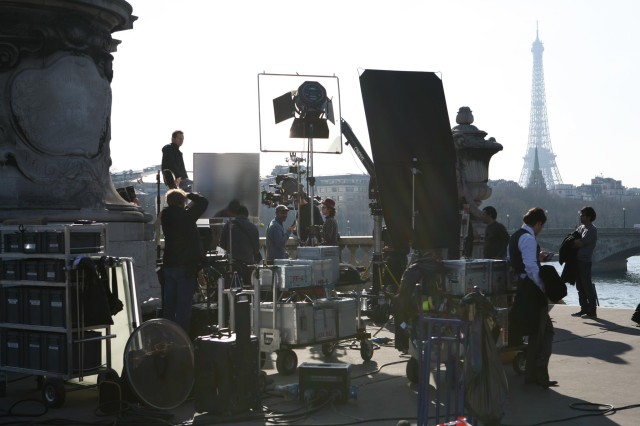Sebastien Gonon reports from Paris about shooting a major campaign of shampoo commercials on 35mm film (Kodak Vision3) with ARRI 435 cameras using anamorphic lenses (Hawk V-Lite 1.3x squeeze). Vantage Paris supplied the camera and lens package.
The concept was atmosphere and mood: girl walking, meeting a guy, a hug, beauty, Paris. To help define the look, agency, client and the creative team looked at fashion photographs. The ones they liked had oval bokehs—oblong out of focus highlights. Anamorphic. Sebastien Gonon was the cinematographer.
They decided on 1.3x squeeze Hawk Anamorphics, shooting on Kodak Vision3 250D and 500T film, with a 4-perf, full frame anamorphic 1.37:1 aperture. The end result would be television spots, which on most screens worldwide is 1.78:1 (16:9). The math works nicely: 1.3 x 1.37 = 1.78.
Sebastien said, “1.3x anamorphic looks different. It falls off out of focus faster than spherical. It’s contrasty but smoother, and wonderful for faces.” Locations included the Sorbonne, the International Diplomatic Academy, and the Alexander III Bridge (also recently seen in the end scene of Midnight in Paris).
The lens package consisted of almost the entire set of Hawk 1.3x V-Lites: 28, 35, 45, 55, 65, 80, 110 mm, a Hawk-anamorphosed 1.3x Angenieux 24-290 (32-380 T3.2 mm) and a Hawk 1.3x Nikon 300 (400mm T2.3).
The camera package included an Arriflex 435 camera with IVS-HD, shooting at 60, 90 and 150 fps and 1000 foot magazines to avoid constantly reloading their film.
On this production, they wanted a fluid, flexible style. They used a BOA crane, similar to Ken Hill’s Z-Jib with a 3-axis underslung Weaver-Steadman head.
Sebastien Gonon grew up in Saint-Héand, home of Angénieux. In fact, his younger brother works at Angénieux. Sebastien studied math, moved to Paris for a job at Cinecam, then worked as a camera assistant for 7 years, doing a lot of slow motion and Photosonics work. Still photography was first love. He spent weeks and weeks printing his negatives. He uses an analog Leica MP camera and his favorite lens is a classic 75 mm Summicron.
Sebastien said, “It’s not a conflict of film vs digital, because we always combine the two in post. Shooting on film, I find the depth of field is smoother. In digital, the colors feel calculated and interpolated. Maybe I say that because of my math studies. The look, I find, is different. The book that had a huge impact on me is “The Negative” by Ansel Adams. The zone system approach of understanding contrast and other things were the best help I ever got.
“In 4-perf, anamorphic 1.3x squeeze is important because it uses the maximum size of the negative. (466 mm2 compared to 340 mm2 for Super35 1.78 spherical. We want to use more pixels—not to count pixels—but for the look.
“The look is not just higher definition from the full negative. It is the look of the anamorphic bokehs, and from the film, not only the grain, but the intermediate grays and organic colors.”
- Lab: Digimage Le Lab; Telecine: Medialab
- Colorist: Didier le Fouest; Focus Puller: Fred Grosso
- Gaffer: Philippe Gibert; Key Grip: Stéphane Canda









